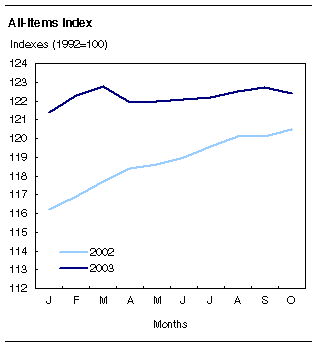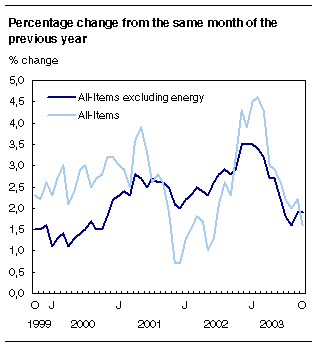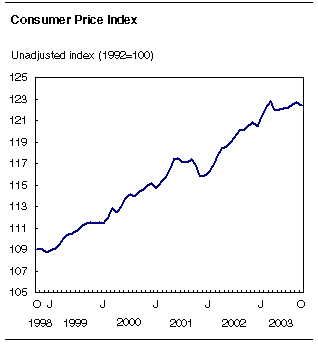
















 |
|
 |                |
Information identified as archived is provided for reference, research or recordkeeping purposes. It is not subject to the Government of Canada Web Standards and has not been altered or updated since it was archived. Please "contact us" to request a format other than those available.

|

Wednesday, November 19, 2003 Consumer Price IndexOctober 2003From September to October, the Consumer Price Index (CPI) fell 0.2%, mostly the result of important price declines for gasoline and natural gas. This monthly decrease combined with the 0.3% increase from September 2002 to October 2002 (base effect) contributed to lowering the 12-month increase in the CPI from 2.2% in September to 1.6% in October, the smallest since June 2002. This slowdown is entirely due to energy prices, as October's 12-month advance in the CPI excluding energy matched that of September, at 1.9%. 
Factors contributing to the increase in the CPI from October 2002 to October 2003Important factors contributing to the 1.6% increase in the CPI from October 2002 to October 2003 included automotive vehicle insurance premiums, natural gas, tuition fees, homeowners' replacement cost, homeowners' insurance premiums and restaurant meals. Lower prices for automotive vehicles, electricity, gasoline, clothing, and traveller accommodation exerted some downward pressure on the 12-month increase in the CPI.
Automotive vehicle insurance premiums increased on average 18.9% from October 2002 to October 2003, while premiums for homeowners' insurance were up 13.9%. Natural gas prices jumped 15.6%, with price advances ranging from 4.8% in Quebec to 24.1% in Ontario. Tuition fees, represented by university fees, rose 8.1%. Homeowners' replacement cost, which is a measure of the depreciation of a house and is estimated by the changes in the price of new housing (excluding land), was up 6.6%. The 2.6% rise in the price of restaurant meals is mostly due to higher prices for some food products and increases in operational costs. 
In October, automotive vehicle prices were 2.9% lower than in October 2002. The index for the purchase of automotive vehicles, which reflects only pure price variations and not price variations associated with quality changes, is at its lowest level since October 1996. The electricity index declined 5.6%, as Ontario prices fell 13.0% from October 2002 to October 2003 after the provincial government reverted back to a regulated market in December 2002. Over the same period, gasoline prices fell 3.2%, while clothing prices decreased 2.9%. Clothing prices have been trending down for over two years. Traveller accommodation prices have also been trending down, as the 12-month comparison has been negative since June 2001. They fell 8.1% from October 2002 to October 2003. The tourism industry has been affected by a number of factors, including the economic slowdown in the United States, a higher Canadian dollar, the world's instability and the severe acute respiratory syndrome (SARS) outbreak. Slight decrease in the CPI from September to OctoberThe CPI decreased 0.2% from September 2003 to October 2003, ending its slow moving upward trend of the previous five months. Lower prices for gasoline, natural gas, traveller accommodation, and automotive vehicles exerted downward pressure on the All-items CPI. Upward pressure came from price increases for property taxes, beef, as well as homeowners' maintenance and repairs. Excluding the influence of energy prices, the CPI remained stable from September to October. Gasoline prices fell on average 6.6% between September and October. Price decreases ranged from 2.2% in Prince Edward Island to 11.1% in Manitoba. Stronger declines were observed in the Western provinces. After increasing in September, the natural gas price index decreased 8.3% in October, mostly under the pressure of price declines in Ontario and Alberta. In Ontario, utility companies have adjusted rates to reflect lower forecast prices for the coming year, while in the deregulated market of Alberta, rate adjustments were made to reflect lower gas wholesale prices. Traveller accommodation prices dropped an additional 6.1% in October, after falling 4.5% in September, which marked the end of the peak tourist season. Automotive vehicle prices were down 0.7% in October, reflecting more important incentives from some manufacturers in the attempt to clear the 2003 models. Prices for the 2004 models will be reflected as of the November CPI. 
Property taxes rose 2.8%, as higher taxes were registered in all provinces. Increases ranged from 0.3% in Newfoundland and Labrador and Manitoba to 6.4% in Alberta. Most of the advance coincided with increases in property re-assessments in Ontario, British Columbia and Alberta. Changes in property taxes are reflected in the CPI once a year in October. Beef prices advanced 4.7% from September to October 2003, after five consecutive months of declines. Increased demand in July and August combined with the partial resumption of exports to Mexico and the United States reduced the oversupply created by the case of bovine spongiform encephalopathy (BSE) found in Alberta in May 2003, pushing prices up. Homeowners' maintenance and repairs rose 1.3% in October, entirely the result of higher prices for material, more particularly carpets. The seasonally adjusted CPI remained stable from September to October 2003After seasonal adjustment, the CPI remained unchanged from September to October. The impact of lower seasonally adjusted indexes for transportation (-1.6%) and health and personal care (-0.1%) was counterbalanced by the upward pressure from higher indexes for shelter (+0.3%), recreation, education and reading (+0.3%), household operations and furnishings (+0.2%), food (+0.1%), clothing and footwear (+0.3%), and alcoholic beverages and tobacco products (+0.2%). All-items excluding the eight most volatile componentsThe All-items index excluding the eight most volatile components as defined by the Bank of Canada rose 1.8% from October 2002 to October 2003. This follows a 12-month advance of 1.7% in September and makes it the fourth consecutive month of increases below the 2.0% mark. Mostly contributing to the rise in October, were higher automotive vehicle insurance premiums, tuition fees, homeowners' replacement cost, homeowners' insurance premiums and restaurant meal prices. Lower prices for automotive vehicles, electricity and clothing helped moderate the impact of these increases on the All-items CPI. From September to October, the All-items index excluding the eight most volatile components as defined by the Bank of Canada advanced 0.2%. Upward pressure came mostly from higher property taxes, as well as higher prices for beef and spectator entertainment. Lower prices for traveller accommodation, automotive vehicles, non-alcoholic beverages and women's clothing exerted some downward pressure on the index. EnergyEnergy prices were down 1.0% from October 2002 to October 2003. This decrease marks the end of a year of 12-month increases. Lower electricity prices (-5.6%) combined with weaker gasoline prices (-3.2%) mostly explain the decrease, helped somewhat by falling fuel oil prices (-8.0%). The 15.6% jump in natural gas prices, however, partially offset these downward pressures. From September to October, energy prices fell 4.5%, due mostly to important price declines for gasoline (-6.6%) and natural gas (-8.3). Fuel oil prices also decreased (-3.8%), while electricity prices increased slightly (+0.3%). Available on CANSIM: tables 326-0001, 326-0002, 326-0009, 326-0012 and 326-0016 to 326-0018. Definitions, data sources and methods: survey number 2301. Available at 7 a.m. on our website. From the home page, choose Today's news releases from The Daily, then Latest Consumer Price Index. The October 2003 issue of the Consumer Price Index (62-001-XIB, $9/$83; 62-001-XPB, $12/$111) is now available. The November 2003 Consumer Price Index will be released on December 19, 2003. For more information, or to enquire about the concepts, methods or data quality of this release, call Rebecca McDougall (1-866-230-2248; 613-951-9606; fax: 613-951-1539) or Ron Morency (613-951-3103), Prices Division
| |||||||||||||||||||||||||||||||||||||||||||||||||||||||||||||||||||||||||||||||||||||||||||||||||||||||||||||||||||||||||||||||||||||||||||||||||||||||||||||||||||||||||||||||||||||||||||||||||||||||||||||||||||||||||||||||||||||||||||||||||||||||||||||||||
|
|
|